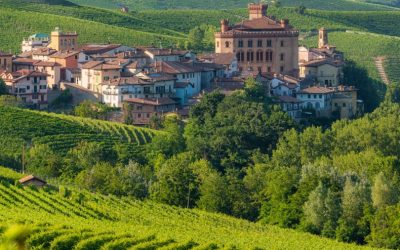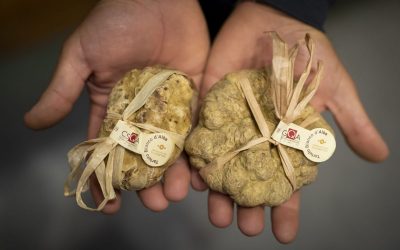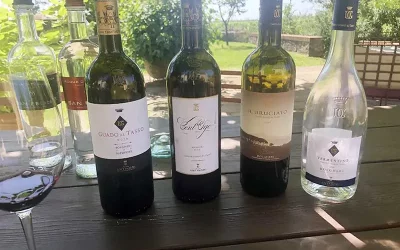Truffle Varieties Around the World: The Global Guide to Expanse of Truffles
Truffles are a fascinating and highly prized culinary ingredient. These enigmatic fungi are found around the globe and vary greatly in appearance, aroma, and flavor. From the celebrated white truffles of Alba in Italy to the black Perigord truffles of France and the vibrant red truffles of North Africa, the world of truffles is vast and diverse. In this article, we will embark on a journey around the world, exploring the different types of truffles, their unique characteristics, and their significant role in global cuisine.
The most expensive white truffle in the World

The most expensive truffle ever sold was found by Luciano Savini and his dog Rocco. They are from Italy, where truffle hunting is a longstanding tradition. The Savini family is well-known in the truffle business and has been dealing with truffles for many generations. The record-breaking truffle was auctioned in Macau in 2007 and was purchased by Stanley Ho, a billionaire and casino owner from Hong Kong, for a staggering $330,000 to Stanley Ho, a billionaire from Hong Kong. The truffle weighed 1.5 kilograms, and its high price was due to both its size and the strong demand for white truffles in high-end cuisine.
Truffle Varieties Around the World: A Detailed Exploration
| Region | Truffle Varieties |
|---|---|
| Europe (Italy, France, UK, Spain) | White Truffle of Alba, Black Truffle, Desert Truffle, Tuber Aestivum, Tuber Mesentericum |
| Asia (China, India) | Tuber Himalayense, Tuber Indicum, Tuber Sinense, Desert truffles (Terfezia species) |
| North America | Pecan Truffle, Oregon truffles (Tuber Oregonense, Tuber Gibbosum) |
| Australia | Tuber Melanosporum, Tuber Aestivum |
| Africa (Morocco, Algeria) | Desert truffles (Terfezia species) |
| South America (Chile, Argentina) | Tuber Macrosporum |
In the verdant landscapes of Europe, truffles have embedded themselves in the culinary traditions of many nations. Italy is revered for its White Truffle of Alba, aptly termed the ‘diamond of the kitchen’, and the robustly flavored Black Truffle which also finds prominence in the French Perigord region. Spain, with its Desert Truffle, and the United Kingdom with its cultivation of Tuber Aestivum and Tuber Mesentericum, enrich the continent’s truffle repertoire. What region in Italy is best for truffle hunting?
Transitioning to the eastern lands, Asia, particularly China, offers a variety of truffle species, including the Tuber Himalayense, Tuber Indicum, and Tuber Sinense. Not far off, India takes pride in the Tuber Himalayense and its desert truffles. Across the Pacific, North America’s diverse landscapes yield the Pecan Truffle and the Oregon truffles. Australia has embraced the truffle culture by successfully cultivating European varieties like the Tuber Melanosporum. Meanwhile, the arid terrains of Africa, especially in Morocco and Algeria, produce the unique desert truffles. South America’s contribution, although lesser-known, is significant with varieties like the Tuber Macrosporum found in Chile and Argentina. This vast array from different continents showcases the rich tapestry of truffle varieties that the world has to offer.
Truffles in Europe:
Europe is known as the traditional heartland of truffles, housing some of the most revered varieties. In Italy, the White Truffle of Alba (Tuber Magnatum Pico) is globally renowned, often called the ‘diamond of the kitchen’ due to its exquisite taste and high price. The Black Truffle (Tuber Melanosporum), primarily harvested in France and Italy, is another beloved variety with its robust flavor. In France, the Perigord region is particularly famous for this truffle, and it’s celebrated with annual festivals. Spain, although less known internationally for truffles, boasts an impressive range, including the Desert Truffle (Terfezia Arenaria). The United Kingdom also cultivates truffles, predominantly the Tuber Aestivum and Tuber Mesentericum.
Truffles in Asia and North America:
Asia’s contribution to the truffle world is often underestimated. China hosts several truffle species, such as the Tuber Himalayense, Tuber Indicum, and Tuber Sinense, which are utilized extensively in local cuisine. India also cultivates Tuber Himalayense and desert truffles (Terfezia species). On the other hand, North America, with its varied climates and environments, supports native truffle species like the Pecan Truffle (Tuber Lyonii) and the Oregon truffles (Tuber Oregonense and Tuber Gibbosum). Recent years have seen an increased interest in truffle cultivation across the continent.
Truffles in Australia, Africa, and South America:
Australia has successfully cultivated imported European truffles, with Tuber Melanosporum (Perigord Black Truffle) and Tuber Aestivum being prevalent. The African continent, specifically Morocco and Algeria, is known for its desert truffles (Terfezia species), a different variety that thrives in arid environments. South America, particularly Chile and Argentina, have been found to host Tuber Macrosporum, adding to the diversity of truffle species worldwide.
Every continent contributes uniquely to the world of truffles, presenting a diverse range of species that enrich global cuisine and fascinate mycologists. These underground fungi, once known only to certain regions, have become a worldwide culinary treasure.
Why White Truffles Cost Up To $75K Per Pound

White truffles are known as the “Diamonds of the Kitchen” and command high prices due to several factors:
- Rarity: White truffles cannot be cultivated or farmed in the same way as other fungi. They grow naturally in the wild and have a symbiotic relationship with the roots of specific trees, particularly oak and hazelnut, in very specific soil and climatic conditions. They are mostly found in certain regions of Italy, particularly in Alba in Piedmont, during a limited season, which usually runs from late September to December.
- Harvesting: The process of finding truffles is labor-intensive and time-consuming. Truffle hunters traditionally use trained dogs or pigs to sniff out the truffles underground. Once located, truffles must be carefully extracted from the earth to prevent damage.
- Quality and Size: The quality, size, and aroma of the truffle significantly impact the price. Larger truffles with intense aroma and flavor are priced higher.
- Shelf Life: White truffles have a very short shelf life. They begin to lose their aroma and flavor immediately after being dug up, and are best consumed within a few days of harvest. This short shelf life, combined with their fragility, adds to their value.
- Demand and Supply: The demand for white truffles, especially from high-end restaurants and gourmet food enthusiasts, far exceeds the supply, which pushes up the price significantly.
Truffle Varieties and Their Global Impact
Truffles, the hidden gems of the culinary world, have fascinated food enthusiasts and chefs for centuries. These subterranean fungi have a vast lineage with approximately 70 recognized species distributed across continents. Predominantly, Europe, especially Italy and France, stand as stalwarts in truffle production. The famed white truffles of Alba and the rich black truffles from the Perigord region are globally coveted. But the allure of truffles isn’t confined to these nations. Countries spanning from the Iberian landscapes of Spain to the vast terrains of Australia and the fertile grounds of the United States also contribute significantly to the truffle narrative.
However, like many other natural wonders, truffles aren’t immune to the adverse effects of climate change. The delicate balance they maintain with their environment is threatened by escalating temperatures and unpredictable rainfall. Such changes could disrupt the growth cycles of truffles, causing not only a dip in their production but also potentially altering their geographic distribution. This shift poses not just a culinary concern but also raises questions about the economic and cultural implications for regions that have, for long, been intertwined with truffle cultivation. The challenge ahead is not just to enjoy these gastronomic treasures but to ensure they remain an enduring part of our global heritage.
Frequently Asked Questions
1. How many truffle species are there in the world?
There are approximately 70 recognized truffle species worldwide, each with its unique characteristics. These species are spread across various continents, including Europe, North America, Africa, Asia, and Australia.
2. Which countries are known for their truffle production?
Italy and France are renowned for their truffle production, particularly the white truffles from Alba and black truffles from Perigord. However, truffles are also found in countries such as Spain, Australia, and the United States.
3. How is the truffle industry impacted by climate change?
Climate change poses significant challenges to the truffle industry. Rising temperatures and changes in rainfall patterns can affect truffle growth and production, potentially leading to declines in truffle abundance and distribution.
Conclusion
Truffles are indeed one of nature’s most exquisite and intriguing delicacies. Their unique flavors and enticing aromas have captured the palates of many around the world, making them a sought-after ingredient in haute cuisine. However, the truffle industry faces significant challenges due to climate change and overexploitation, necessitating effective conservation strategies to safeguard these precious fungi for future generations.





